-
Shop
- 🔥 Warehouse Clearance Sale 🔥
- Ergonomic Mice
- Ergonomic Keyboards
- Specialised Ergonomic Mice
- Standing Desks
- Ergonomic Chairs
- Laptop Stands & Risers
- Monitor Risers
- Computer Monitor Arms
- Footrests
- Wrist and Forearm Supports
- Back Supports
- Tablet Accessories
- Boardroom Chairs
- Headsets
- Other Ergonomic Equipment
- Online Ergonomic Training Courses
- New Products

- For Customers
- For Business Customers
- For Health Professionals
- About Us
- Reviews
Carpal Tunnel Syndrome
Ergonomic Considerations
What is Carpal Tunnel Syndrome?
Carpal Tunnel Syndrome (CTS) is an upper limb injury caused by compression of the median nerve, which runs from the forearm into the palm of your hand. The median nerve is responsible for the control of sensation to the palm side of the thumb and your fingers (excluding your little finger). The median nerve also controls the movement of your thumb and fingers.
The carpal tunnel is a small tunnel of ligament and bones at the base of your hand. Compression of the median nerve can be caused by swelling of the irritated tendons, which in turn causes pain, weakness, and/or numbness in your hand and wrist.
What Causes Carpal Tunnel Syndrome?
Carpal Tunnel Syndrome is often caused by a combination of things that all lead to pressure over the median nerve. In some instances, CTS is a result of congenital predisposition, that being the carpal tunnel is just smaller in diameter in some people. Other factors may include sustaining an injury to your wrist that results in swelling around the base of the wrist, use of vibrating hand tools or even fluid retention. However, the most common cause of Carpal Tunnel Syndrome is as a result of a repetitive strain injuries relating to computer use.
Heavy use of a computer mouse or keyboard, combined with awkward working postures of the hands and wrist, can result in a repetitive strain injury to the wrist/s. This in turn causes swelling around the wrist which leads to increased pressure over the median nerve, resulting in the onset of Carpal Tunnel Syndrome.
How is Carpal Tunnel Syndrome Treated?
There are both surgical and non-surgical treatments available for it. Initial treatment should generally involve resting the affected hand/s for at least a few weeks, in order to help the swelling reduce. During this time you should also avoid any activities that may aggravate your symptoms. If you consult with a Physiotherapist, you may find they recommend immobilizing your wrist by placing it in a splint. This will help to avoid further aggravation from moving or bending your wrist. Applying ice packs can also help reduce your swelling.
Carpal Tunnel Syndrome can be treated, and in most instances can be resolved.
What Ergonomic Equipment is Recommended for Carpal Tunnel Syndrome?
It is important to consider your working environment when looking at treating Carpal Tunnel Syndrome. Once you have consulted with your GP and a Physiotherapist, and your symptoms are beginning to improve, you may want to try to re-introduce using a computer mouse and keyboard again. Remember to start slowly and gradually increase the amount of time you use your mouse and keyboard for.
If you find your computer keyboard and mouse aggravates your symptoms, you may need to consider changing them to an ergonomic model.
Ergonomic keyboard and mice, place your wrist and forearms in a more natural posture that helps to reduce the pressure over the median nerve and reduce the amount of muscle activity required to use your mouse and keyboard. The important aspect here is to try to get your hands into a more neutral working posture, as this will help to reduce any aggravation of your symptoms.
Recommended Ergonomic Mice for Carpal Tunnel Syndrome
A vertical mouse will help to put your wrist in a neutral posture. This change in working posture will help to alleviate some of the pain symptoms you may be experiencing. Below is our top 3 recommended Ergonomic Mice for Carpal Tunnel Syndrome.
ErgoFeel Vertical Mouse
The ErgoFeel Vertical Ergonomic Mouse is a great choice for anyone experiencing Carpal Tunnel Syndrome. The mouse is designed to place your wrist in a more comfortable posture that will take the pressure of your median nerve.
Wired or Wireless Models
Left or Right Hand Models
Ideal for Carpal Tunnel Syndrome
Ease Vertical Mouse
The Ease Vertical Ergonomic Mouse has a lovely curvature that fits ever so nicely in the palm of your hand. The addition of a molded thumb rest also makes it easy to grip. Similar to the ErgoFeel Mouse, it will help to change your wrist posture and alleviate pressure over the median nerve when you use your mouse.
Wireless Model
Left or Right Hand Models
Ideal for Carpal Tunnel Syndrome
ErgoSlider Plus
The ErgoSlider Plus is an alternative mouse that is designed to be placed in front of a keyboard. This position allows your arms to be in a complete neutral position. Also, the roller bar that controls the mouse cursor provides a no-grip, ambidextrous solution for someone who is rehabilitating from Carpal Tunnel Syndrome.
No gripping necessary
Ambidextrous solution
Ideal for Carpal Tunnel Syndrome
Recommended Ergonomic Keyboards for Carpal Tunnel Syndrome
Your keyboard could also be aggravating your pain symptoms. Consider switching to an ergonomic keyboard that is slim in design and has low profile keys. This will help to reduce unnecessary wrist extension
Ease Compact Keyboard
The Ease Compact Keyboard is ultra slim and thin. This makes it great for users with carpal tunnel syndrome as it will reduce pressure over the median nerve by reducing unneccesary wrist extension.
Wireless Model
Low profile keys
Ideal for Carpal Tunnel Syndrome

Compact Mini Ergonomic Keyboard
The Compact Mini Ergonomic Keyboard is ultra thin and has low profile keys meaning less wrist extension when typing. It is another great option for users with Carpal Tunnel Syndrome.
Wireless Model
Low profile keys
Ideal for Carpal Tunnel Syndrome







